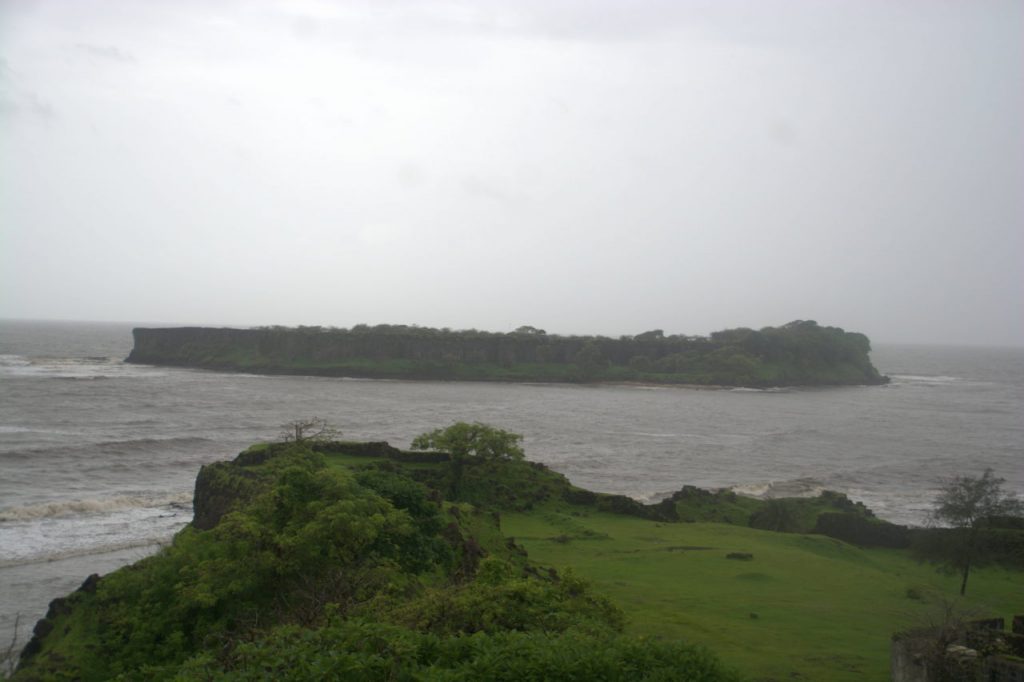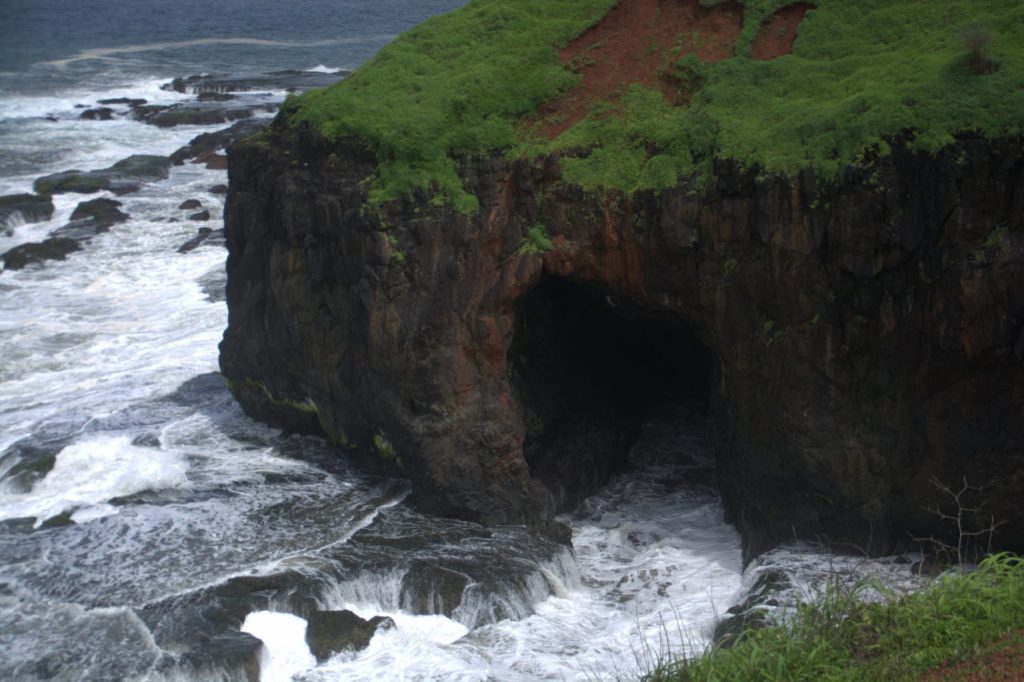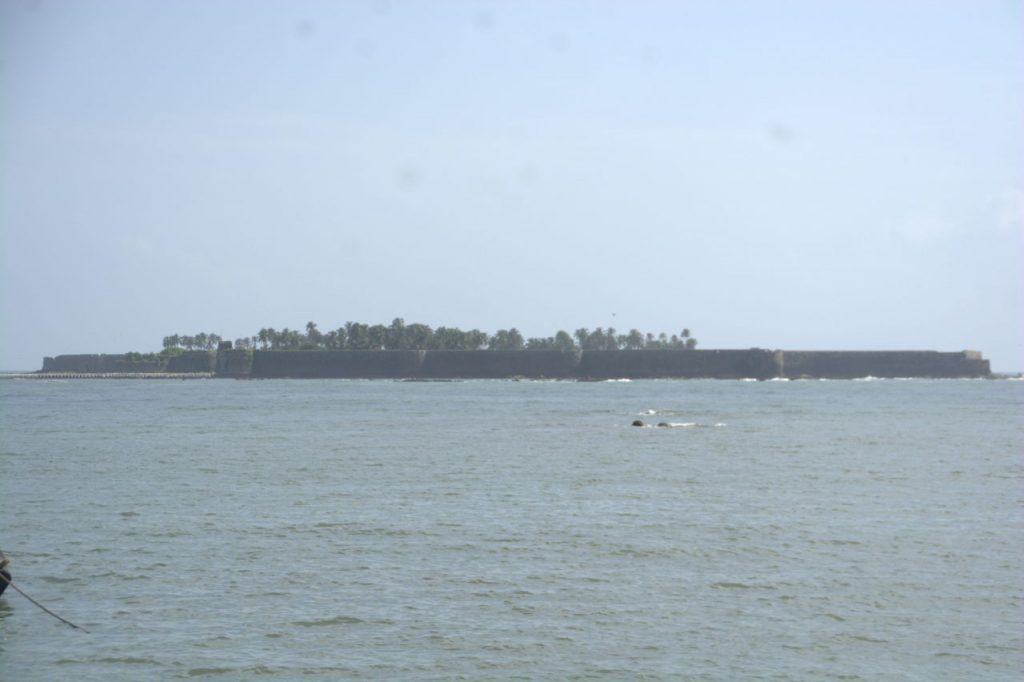Between the late 17th century to the early 19th century, the Maratha empire had a formidable navy. Started by Chhatrapati Shivaji Maharaj as a way of countering invastion by foreign forces from the west coast of India, the navy flourished under the Peshwas with the able commandership of admiral Kanhoji Angre. Maharashtra’s coastline was particularly strong because of the presence of some strong forts along the coastline. While not all of them were built by the Marathas, several of them were captured by them and held for more than a century. Most forts fell to the hands of the British when the Marathas were defeated in 1818.
Here is a glimpse of the most important sea forts in Maharashtra.
Kolaba fort, Alibag
Not to be confused with Mumbai’s posh locality of Colaba, the Kolaba fort is just off the sea from the town of Alibag, the headquarters of Raigad district. The construction of the fort began during the rule of Chhatrapati Shivaji in the late 1670s. After his death, the construction was completed during the rule of his son Sambhaji. During the rule of the Peshwas, the fort was handed over to navy admiral Kanhoji Angre along with other forts along the Konkan coast.
- Kolaba fort as seen from Alibag
- Walking to Kolaba in ankle deep water
- Cannon guns on the bastion of Kolaba fort
The fort was the source of several attacks on British bases and ships in Konkan. The incensed British tried to retaliate with the help of Portuguese, but were beaten several times. It finally fell to the British after the death of Angre and the defeat of Peshwas.
The fort is situated on a rocky sea bed just off Alibag. One can see bastion walls that overlook the sea, freshwater wells and the temple of Lord Siddhivinayak inside the fort. There are shops inside the fort. These are operated by the residents of Alibag. But they close after 6 pm as the shop owners leave the fort to go home. There are two gates in the fort, one that faces Alibag to the east and another one that faces the depths of the sea to the west.
The high tide at Alibag lasts until late afternoon, after which the the low tide takes over. The water near the shore recedes significantly. During winters, the sea recedes so far back that you can walk to the fort in ankle-deep water. Or you can take a bullock cart to the fort’s east gate. During high tide, you can take a boat to the east gate. During monsoon, you aren’t allowed to go to the fort during high tide, whereas you can take a boat during low tide.
Revdanda fort, Chaul
Chaul is a town midway between Alibag and Murud. It used to be a port city during the time of Rashtrakutas, Portuguese and Marathas. The commercial status of Chaul is lost today, but there is enough history to be seen on its coastline. A couple of forts, Revdanda and Korlai are good places to look back to the history.
- Beach near Revdanda fort.
- Priya enters Revdanda fort, Alice-in-wonderland style.
- Watch tower at Revdanda fort.
Chaul town is at the location where Kundalika river from the Sahyadris joins the Arabian sea. River mouths usually make excellent ports and Chaul was the same. The Portuguese guarded this important port with an on-port fort. The port was called Revdanda and is also the name of the fort today.
The entrance to the fort is on the southern wall, but you can also gain an entry through the window on the western wall of the fort from the Revdanda beach. Inside the church, you will see the mutliple chambers inside the fort, an indication that there were several offices and quarters inside. The remains of a church and a watch tower can also be seen. Also strewn around the fort are cannon guns and balls.
Korlai fort, Chaul
This Portuguese-built fort is on a spur of land that juts into the sea between Chaul and Murud. The spur ends as a hill, with Korlai village at the base of the hill. The fort itself is at the top of the hill. With its vantage view, Korlai fort overlooks Revdanda fort, the sea and the entire coastline between Alibag and Murud, thus making it an ideal location to protect an important trade route through Konkan.
- Korlai village with the beach seen from Korlai fort.
- A small chapel at the top of Korlai fort.
- The outer walls of the Korlai fort, which is hill top fort right near the sea. Projection: Cylindrical (1) FOV: 170 x 62 Ev: 12.06
The fort campus itself has several artefacts from its Portuguese heyday. There are the ruins of a church. Then there are several carvings in Portuguese, Latin and Creole. The fort flourished as a Portuguese military hub until it was captured by the Marathas. After the British captured the fort, they left it in ruins. Several stones and wood planks from the fort were used by the British to build buildings in Alibag and Murud.
The inhabitants of Korlai village still show trace of Portuguese ancestory. They speak a dialect of Creole that incorporates plenty of Marathi and Konkani. This dialect is named Kristi, perhaps a variation of the word Christian, since the Portuguese converted a mass of people along the west coast to Christians and anyone adopting their languages or dialects were usually converted Christians.
Janjira, Murud
Murud Janjira is one of the most celebrated sea forts in Maharashtra. It was built by the Siddis of Ethopia (then called Abyssinia), whose descendents continue to live at Rajpuri village, a coastal village within the municipal corporation of Murud in Raigad district. Rajpuri also features the jetty from where one can reach Murud Janjira fort by boat.
- Murud Janjira fort as seen through overcast weather from the Murud jetty.
- A palace inside Janjira
- Janjira bastions and Rajpuri village as seen from the citadel of Janjira.
Murud Janjira was never captured despite several attempts by multiple armies including Marathas and British. Subsequently, Marathas built their own fort named Padmadurg (which now belongs to the Indian navy) on an island more inside the sea compared to Janjira. Inside Murud Janjira, one can see multiple levels of fort walls, bastions and fresh water wells. But the most unique feature are three secret underground passages, that led to different point in Rajpuri village. Using these passages, the Siddis could discreetly escape a siege, bring reinforcements and turn the battle in their favour by completely surprising the enemy.
The descendents of Siddis were so fond of the fort that they continued to live in it until the 1970s. But the hassle of having to commute to the shore by boat, the lack of electricity and lack of opportunities inside the fort forced them to relocate to Rajpuri. Also, the fort used to flood during monsoon and get caught in the middle of high tide, cutting the fort from the land.
Twin forts at Harnai
At the coastal town of Harnai in the Dapoli tehsil of Ratnagiri district, we can see two forts, one on land and one inside the sea. The land fort is simply referred to as Harnai fort, whereas the sea fort is named Suvarnadurg. The two were built to guard the trading route in Ratnagiri district.
- Harnai village and Suvarnadurg fort as seen from the coastal highway which bypasses the village.
- Main gate of Harnai fort.
- Suvarnadurg fort as seen from Harnai fort.
The Harnai forts were built by the Adil Shah Sultanate of Bijapur in Karnataka, who had frequent swipes at the Marathas. But the forts landed into the hands of Marathas once and for all after Shivaji captured them with a resounding win and the Peshwas handed them to the able hands of admiral Kanhoji Angre. The British captured it along with all of Konkan in 1818.
Alongside the forts, Harnai also has a lighthouse that used to guide ships to the coast of Ratnagiri.
Jaigad fort, Ganpatipule
Jaigad fort is at the mouth of Shastri river, just to the north of the pilgrimage village of Ganpatipule. It is about 30 km to the north of Ratnagiri city. Across the river to the north are Guhaghar and Velneshwar.
- Kanhoji Angre’s palace at Jaigad fort
- Datta temple at Jaigad fort
- Ferry service between Jaigad and Tawsal as seen from Jaigad fort
Jaigad was built by Adil Shah, but captured for the Marathas by the Naiks of Sangameshwar. It continued to be held by the Marathas until 1818.
Jaigad fort served as the home of admiral Kanhoji Angre during the peak of Maratha navy strength. Inside the fort, you can see bastion walls that overlook the sea, along with guard towers along the bastion at regular intervals. Inside the fort complex are a Datta temple and the ruins of the palace of admiral Kanhoji Angre.
Ratnadurg fort, Ratnagiri
This fort is on the top of a hill that is to the west of Ratnagiri city. There are two hills, one with Ratnadurg fort and the neighbouring hill with Ratnagiri lighthouse. Both of them offer a commanding view of the sea.
- A naturally formed cave at the base of the hill with Ratnadurg fort. The waves have carved out a huge cave from the rock.
- Bhagwati temple at Ratnadurg fort
- A statue of Kanhoji Angre, naval admiral of Shivaji. He was responsible for keeping the Maratha empire safe from marine attacks.
Ratnadurg was built by the Bahamani Sultanate (present day Telangana), but captured by Shivaji. It came to the hands of Kanhoji Angre in the early 19th century. Like all of Konkan, it was annexed by the British in 1818.
The fort is surrounded by bastions with several lookout points, each point having a name of its own. Inside the fort complex is a Mata Bhagavati temple. In front of the temple is a statue of the bust of Kanhoji Angre.
Vijaydurg, Sindhudurg district
Vijaydurg is the oldest fort in Sindhudurg district. it is situated on a north-facing spur in Devgad tehsil of the district. The fort is surrounded by sea on three sides, with only the south side overlooking the narrow spur of land that keeps the fort in the mainland. The narrow spur also has Vijaydurg village.
- A view of Vijaydurg fort from the village
- Walkway made of cannon balls at Vijaydurg.
- Bastions inside Vijaydurg fort
The fort was built by the Bahamanis and captured by Marathas during the rule of Shivaji. The Marathas added several modifications to the fort to strengthen it further. Inside the fort, there are multiple levels of ramparts. There is an outdoor section which is purely military. The fort also has an indoor section that used to house a palace, an ordnance, a granary and official quarters.
It is said that British astronomer Sir Joseph Norman Lockyer used the Vijaydurg fort to record his observations of the sun. It is from here that he discovered that the surface of the sun has helium. Hence the World Helium Day has been acknowledged on this fort since 2009.
Devgad fort, Devgad
- Devgad fort walls and the light house.
- Our car near Devgad fort
Devgad fort is a sea facing fort on a small hill to the north of Devgad town. The fort is in the vicinity of Devgad lighthouse. Devgad fort was built during the time of Kanhoji Angre, hence making it a younger fort compared to others in the area. The fort fell to the British during 1818.
Sindhudurg fort, Malvan
Sindhudurg fort is a sea fort off the coast of Malvan. It can reached by boat from the Malvan jetty. The fort and the jetty are closed during monsoon and reopen in September. During our trip, we were lucky enough to drive into Malvan right on the day that the fort reopened.
- Sindhudurg fort from Malvan
- At Sindhudurg fort
- Bastion of Sindhudurg fort
The fort was built by Shivaji to curb English, Portuguese, Dutch, French and Siddi activity in southern Maharashtra and neighbouring Goa, which was a Portuguese powerhouse and a potential threat to Konkan. The fort is built with stone, but reinforced with lead at points where the Marathas did not want to break down with ammunition.
inside the fort, you can see several bastion wall, granaries, official quarters, temples and ordnance. There are also several watch towers. There are two secret passages in the fort, one leading to Malvan and another to Tarkarli village just south of Malvan.
The fort was inhabited even as recently as the 1990s. But the hassle of commute and the lack of opportunities made the residents shift to Malvan, Tarkarli and Vengurla for work. But 15 families live on the fort even today.
Conclusion
While our list of sea forts is not exhaustive, this article attempts to explain the historically most significant forts in Konkan. There are several others like the Bandra fort in Mumbai and Terekhol fort at the border of Maharashtra and Goa. But not all forts are preserved or maintained, while some of them have been converted to hotels, naval offices and promenades. Just looking at sea forts in Maharashtra will tell you volumes about the importance of sea routes in Maharashtra’s economy and warfare. They will also tell you loads about the strength of the Maratha navy fleet.






























